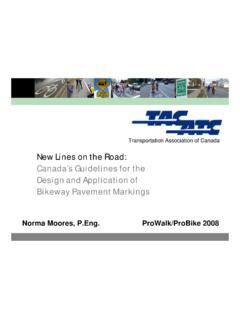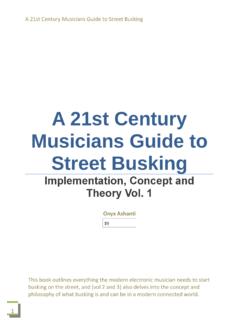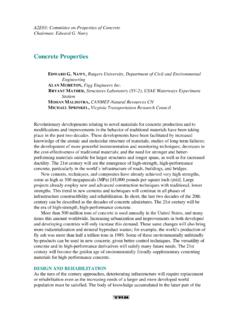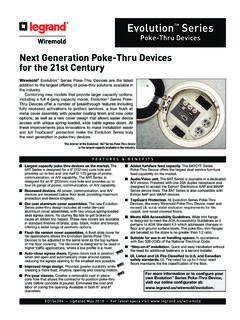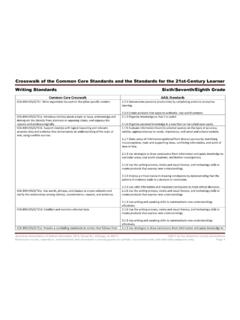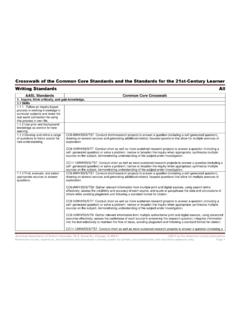Transcription of Accessible Sidewalks and Street Crossings - …
1 Accessible Sidewalksand Street Crossings an informational Departmentof TransportationFederal HighwayAdministrationFHWA-SA-03-01 Notice:This document is disseminated under the sponsorship of the Department ofTransportation in the interest of information exchange. The United StatesGovernment assumes no liability for its contents or the use report does not constitute a standard, specification, or regulation. The UnitedStates Government does not endorse products or manufacturers. Trade or manufac-turers' names appear herein only because they are considered essential to the objectof this :Copies can be ordered from the website at: on "What's New"IntroductionSection 1: The Legal FrameworkSection 2: Understanding sidewalk UsersSection 3: sidewalk CorridorsSection 4: sidewalk Grades and Cross SlopesSection 5: sidewalk SurfacesSection 6: Protruding ObjectsSection 7: Driveway CrossingsSection 8: Curb RampsSection 9.
2 Providing Information to PedestriansSection 10: Accessible Pedestrian SignalsSection 1 1: Pedestrian CrossingsSection 12: A ChecklistReferences/Websites135791115171 92529313339 Acknowledgements/Author:Leverson Boodlal, PEKLS Engineering47776 Allegheny CircleSterling, Virginia 366-8044 Providing AccessibleSidewalks andStreet CrossingsIn order to meet the needs of all sidewalk users, designers must have a clearunderstanding of the wide range of abilities that occur within the , like roadways, should be designed to serve all users.
3 This includeschildren, older people, parents with strollers, pedestrians who have visionimpairments, and people using wheelchairs and other assistive devices. Just asa roadway will not be designed for one type of vehicle, the design of sidewalksshould not be limited to only a single type of pedestrian user. Because the side-walk is the basic unit of mobility within our overall system of transportation,every route and facility must be facility design and operation must comply with the accessibilitystandards in the Architectural Barriers Act (ABA) of 1968, the RehabilitationAct of1973 (Section 504), and the Americans with Disabilities Act (ADA) of1990.
4 Implementing regulations for Title II of the ADA, which covers State andlocal governments, also address "communications and information access,"requiring 'effective communications' with persons with disabilities. In thesidewalk/ Street crossing environment, this would include Accessible pedestriansignals, markings, and signage. The latest version of the Manual on UniformTraffic Control Devices (MUTCD) contains standards on Accessible PedestrianSignals (APS) that have audible, visual, and vibrotactile features.
5 Thesestandards represent the minimum; designers should use more conservativedesign parameters whenever and alternate pedestrian routes where Sidewalks are obstructed bywork zones must meet accessibility standards, as well. Pedestrians who mustcross the Street and then cross back again in order to continue on theirdestination will be exposed to significantly increased risk from intent of this guide is to focus on some of the emerging accessibility issuesand the design parameters that affect sidewalk and Street crossing design the 1990s, several key pieces of legislation were passed that impactedtransportation planning.
6 The first, the Americans with Disabilities Act (ADA)of 1990, protects the civil rights of people with disabilities. Secondly, the 1991reauthorization of the Federal transportation legislation, the Intermodal SurfaceTransportation Efficiency Act of 1991 (ISTEA), specifically called forintegrating pedestrian travel into the transportation system. ISTEA increasedthe Federal-aid funding options for pedestrian facilities and programs. In 1998,the Transportation Equity Act for the 21st century (TEA-21) extended theopportunities established in ISTEA and increased funding available forpedestrian facilities.
7 These laws complimented more than 40 years oflegislation aimed at guaranteeing the rights of people with is a brief chronological summary of the laws and regulationsmandating Accessible environments and programs:Americans National Standards Institute (ANSI ), 1961: The firstbuilding standard to address issues of Barriers Act (ABA) of 1968 (Public Law 90-480): This wasthe first Federal law requiring new facilities constructed for Federal agencies orwith Federal funding to meet accessibility standards (UFAS).
8 Rehabilitation Act of 1973, Title V, Section 504 (Public Law 93-112, amend-ed by PL 516 and PL 95-602): Section 504 requires federally funded facili-ties and programs to be Accessible to people with of All Handicapped Children Act of 1975 (now The Individualswith Disabilities Education Act (IDEA)): This Act greatly expandededucational opportunities by requiring school accommodations for childrenwith Federal Accessibility Standards (UFAS, Federal Standard 795):The UFAS defined the minimum standards for design, construction, andalteration of buildings to meet the requirements of the ABA.
9 UFAS derivedfrom ANSI A and the Access Board's 1982 Minimum Guidelinesand Requirements for Accessible Design (MGRAD).Americans with Disabilities Act of 1990 (ADA): ADA extends the coverageof the ABA, and the Rehabilitation Act, Section 504 to include all publicfacilities regardless of funding. The Title II implementing regulations for theADA require all newly constructed and altered facilities to be readily accessibleto persons with disabilities. Transportation agencies are responsible fordeveloping a transition plan for removing the structural barriers, includingcommunication barriers, and providing access to existing pedestrian Laws: In some States, codes have been adopted that exceed therequirements set forth in the ADA guidelines .
10 In these States, both the ADAand the State code must be have differing abilities: A variety of users need to access thesidewalk system. Their abilities vary in agility, balance, cognition, coordination,endurance, flexibility, hearing, problem solving, strength, vision, andwalking for all abilities: The design of sidewalk environments is importantto all pedestrians, but is particularly important to those with disabilities whohave limited travel choices and rely most on the pedestrian environment. Forexample, older adults, persons with vision impairments, and children frequentlyrely on the sidewalk to travel independently within their community for shop-ping, recreation, exercise, and walking to , design parameters have been based on the "standard pedestrian,"an agile person with good vision, hearing, and mobility.
